Australia Warns Of A Jump In Iran-Sponsored Cyberattacks
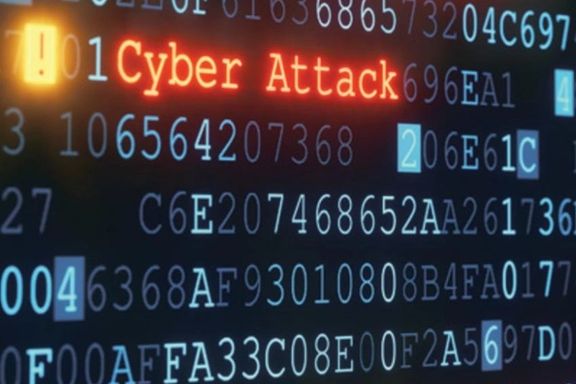
Australia says cyberattacks by state-sponsored groups from China, Russia and Iran have grown significantly, estimating that one attack occurs every seven minutes.

Australia says cyberattacks by state-sponsored groups from China, Russia and Iran have grown significantly, estimating that one attack occurs every seven minutes.
In a report published on Friday, Prime Minister Anthony Albanese said the Australian Cyber Security Centre (ACSC) received 76,000 cybercrime reports last financial year, up 13 percent from the previous corresponding period.
Describing the attacks as a "huge wake-up call," he said they have made cyberspace a “battleground.” "It's a huge wakeup call, and companies need to get their act together...we need to do much better," he said, adding that "The government has stepped up, the private sector needs to step up in the interest of their customers but also their own interest."
Business losses attributable to cybercrime rose on average 14 percent over the period, with the average crime costing a small business A$39,000 ($24,540).
“It’s not just about the frauds or the texts that you or I might receive, but real issues around the security of our country going forward,” Cybersecurity Minister Clare O’Neil said in reference to the report. “It is a national security focus of the government.”
As part of efforts to intensify reactions to cyber threats by the Islamic Republic, the FBI warned late in October that the Iranian cyber group Emennet Pasargad is conducting hack-and-leak operations involving a combination of hacking and theft of data. In November 2021, the Treasury Department sanctioned six Iranian officials as well as the company for their involvement in the planned cyberattack.

While only three weeks ago Iran’s ruler Ali Khamenei described the ongoing uprising as a "riot”, on Wednesday he said it is a "hybrid war" led by the "enemies”.
Speaking on the Student Day, Khamenei said that school children taking part in the uprising are led by their emotions. "These are our children and I do not have anything to say to them," adding his usual conspiracy theories that state media and security forces should deal with those who pull the strings behind the scenes.
Conspirators in his view include the United States, Israel, Europeans, regional countries and any Iranian who is not loyal to him.
Iranian analyst Mehdi Mahdavi Azad told Iran International TV that "This is the first time during the past four decades that Ali Khamenei and his government have not been able to control protests after 45 days, because they are not simply facing a protest. “What we are seeing is a social revolution the government can hardly accept."
"It is hard for the government to admit that a majority of Iranians do not want compulsory hijab, clerical rule, economic crisis and the government's intervention in the Middle east and its support of international terrorism," he said.
Mahdavi Azad added: "What Khamenei said today was not disappointing because no one expected him to say anything else. However, Khamenei and what he said showed that the structure of the Islamic Republic is more rigid and vulnerable than what we imagine."
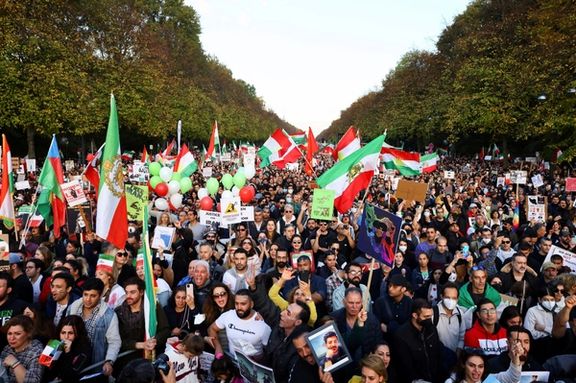
He went on to say that while Khamenei praised the Iranian intelligence community, everyone knows that the joint statement issued last week by the Iranian these agencies offered one of the most banal and conspiracy theory-based analysis of the ongoing developments."
He added: "This analysis showed that the Islamic Republic is no longer able to conduct even a tactical retreat. In fact, Khamenei was saying: I am not changing my position, destroy me or accept me as I am."
Meanwhile, Khamenei warned state officials not to send out message that would be taken advantage of by foreigners. Mahdavi Azad said: "Ali Khamenei is so lonely. His former presidents such as moderate conservative Hassan Rouhani and populist Mahmoud Ahmadinejad have not said a word to support him. The reformists also do not support him. At the same time, Iranians appear to hate him and you can find this out by listening to slogans in various parts of the country. All the rude slogans target him."
The analyst went on to say: "He is also isolated in the world and international public opinion. Inside the country, he is trying hard to rally at least traditional conservative politicians behind him, but even they are clever enough not to align themselves with a notorious character such as Khamenei."
Meanwhile, another Iranian analyst, Alan Tofighi told Iran International: "As you see in the videos of police brutality against the protesters, Khamenei is directly facing the people in what looks like a war. How can anyone beat his fellow country man before shooting him in the head? Those who see those scenes will put Khamenei next to the world's biggest criminals such as Hitler."
Inside Iran, reformist activist Mohammad Ali Namazi has said that "The government has refused to take even one step to restore people's trust." He added that at the starting point of the protests, the government could have disbanded the morality police and amended the compulsory hijab law to calm down the situation, but it refused to offer an olive branch.
Others, including former lawmaker Abouzar Nadimi told reporters that "We need reforms to meet the society's expectations." He pointed out that those who have been thinking about such reforms have reached conclusions about changing the distribution of political power in Iran, but there is no room for such changes in the Iranian constitution.

Special Envoy for Iran Rob Malley says the US will continue to expose the Islamic Republic’s support for the Russian invasion of Ukraine.
In an interview with Al Arabiya published on Thursday, he said, “I think it’s clear that Iran has moved closer to Russia. We think it’s a very bad bed that Iran has made, but it’s clear to the world today that Iran has sided with Russia and its war of aggression against Ukraine.”
Amid international outcry over the Islamic Republic’s supply of drones and ballistic missiles to Moscow, Kiev said earlier in the week that Tehran plans to ship even more arms to Russia. Ukranian intelligence agencies claimed that the Islamic Republic is set to deliver more than 200 Shahed-136 and Arash-2 kamikaze drones, and Mohajer-6 reconnaissance and combat UAVs later in November.
Malley added that “It’s something that we have exposed, that others have exposed, and I think … the first step to take is to make sure the world knows to run, and people know what their government is doing,” noting that “it’s clear as well that the Iranian government is embarrassed by that because they keep denying that they’ve transferred these drones to Russia in the face of mounting and incontrovertible evidence.”
He vowed more punitive measures against “anyone who is related even tangentially to those transfers,” warning that “Any economic operator in the region, or elsewhere, should be very careful about involving themselves in such transfers because we will sanction them.”
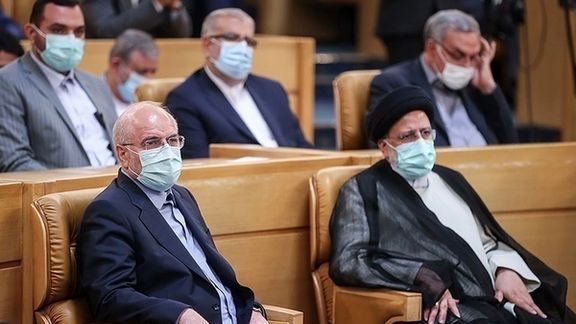
Amid six-weeks of political upheaval in Iran, officials and media speak little about the economy, but the government struggles with an epic revenue shortfall
Mohsen Zanganeh, a member of parliament’s budget committee, who is an engineer and an economist, told Tasnim news website that Supreme Leader Ali Khamenei has agreed to more oil income to be spent for the budget instead of being deposited in the country’s National Development Fund (NDF).
Both President Ebrahim Raisi and Parliament Speaker Mohammad Bagher Ghalibaf are loyal followers of Iran's ruler Ali Khamenei, who has hand picked both officials.
By law Iran must save 40 percent of its oil revenues in the NDF, “for future generation,” but since 2018, successive governments have withdrawn money from the fund to bridge their budgets, with Khamenei’s permission. Now, Zanganeh says that the Supreme Leader has allowed the government to reduce the 40-percent rate of savings to 30 percent and use the 10 percent help with its large budget deficit.
Zanganeh who spoke with Tasnim on Thursday did not mention any numbers, as Iran keeps exact oil revenue figures and the size of the NDF secret. But by most accounts, Iran is exporting anywhere between 750,000 to one million barrels of crude oil daily, mostly to China. But how much discount it offers and how much foreign currency it receives remain secret.
One thing which is clear is that Iran’s $40 billion budget had a deficit of around 70 percent earlier this year. While 79 percent of tax revenues were collected from March 21 to May 20 this year, just 15 percent of official oil revenues in the budget were realized.
There could be two explanations for the huge difference between amount of oil shipped amid high prices earlier this year and what was collected by the government.
One possibility is that Iran is not receiving cash for the oil exports. Many have mentioned barter trade, whereby Iran receives good in lieu of the oil sent to China. The other possibility is that Beijing is keeping the money for now, given United States’ banking sanctions on Iran.
However, oil minister Javad Owji claimed on July 4 that Iran is receiving 80 of oil proceeds in cash and only 20 percent in barter. If this is true, then one can wonder where the money is and how it happened that the government got only 15 percent of what it expected.
This brings us to the second possibility. Cash collected from oil exports does not end up in government coffers and instead it is distributed to secret military projects and among ‘revolutionary’ entities in Iran and abroad whose existence and operations are deemed essential for the regime, controlled by Supreme Leader Ali Khamenei and his hardliner followers.
It has always been known that the official government budget pertains to routine operations, such as civilian ministries and the large public-sector industrial companies, banks, etc.
In the meantime, sporadic protests have gripped the oil and petrochemical sectors since September and the non-stop protests have reduced business activities, especially in the retail sector.
The government must be also printing money, because the inflation rate hovers around 50 percent and the national currency this week hit an all-time low of 340,000 rials to the US dollar.
Ebtekhab website in Tehran reported on Thursday [November 3] that cooking oil prices increased by 377 percent and rise by 207 percent since last year. It was reported in July that food price annual inflation is around 100 percent.
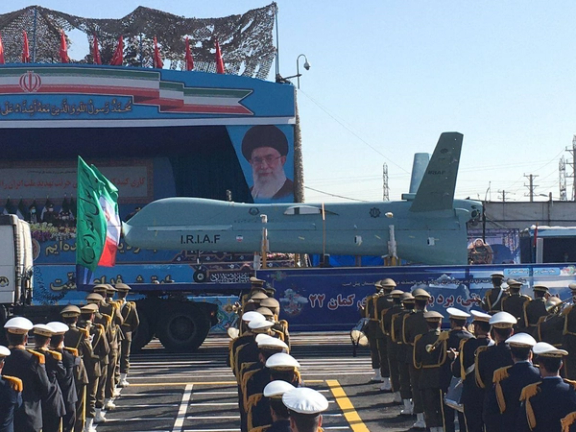
With the reported use of Iranian drones by Russia, the United States and its European allies face the question of reviving international sanctions by ‘snapback’.
What is ‘snapback,’ and why does it matter?
The 2015 Iran nuclear agreement, the JCPOA (Joint Comprehensive Plan of Action), lifted international sanctions against Iran in return for strict limits on the Iranian nuclear program. Under the terms of the JCPOA, the sanctions could ‘snapback’ if Iran violated the agreement.
Is Iran violating the agreement?
Iran began breaching JCPOA limits – for example on the level of uranium enrichment, and with the number and kind of centrifuges in use – in 2019, the year after President Donald Trump withdrew the US from the 2015 agreement and imposed ‘maximum pressure’ sanction.
So why is ‘snapback’ being raised now?
It has come up because France, Germany, the United States and the United Kingdom have told the United Nations that Iran’s reported supply of military drones to Russia for use in Ukraine violates UN Security Council Resolution 2231, by which the council endorsed the JCPOA.
UNSC Resolution 2231 contained a clause that up to October 2023 prior UNSC approval would be needed for the transfer to and from Iran of certain military equipment and weapons. So, the US is arguing that Iran’s supply of drones violates that clause – and this has raised the possibility of snapback, under which multilateral sanctions would come back onto Tehran.
Would the drone supply for sure violate Resolution 2231?
That is yet to be decided. Snapback relates to “significant non-performance of commitments.” Resolution 2231 refers to a 79-page document submitted at the time by the US – S/2015/546 – that listed categories of weapons needing prior UNSC approval. S/2015/546 refers to drones “capable of delivering at least a 50kg payload to a range of at least 300km,” and while Iranian-made Shahed drones can have a range of over 1,000km they carry 40kg of explosives. There would be a clearer violation if Iran transferred Fateh-110 and Zulfiqar missiles, which would meet the criteria.

How would ‘snapback’ work?
Any party to the JCPOA can move snapback. If after 30 days, the issue is not resolved, then UN sanctions would come back into effect. For the issue to be resolved, a UNSC member would need to move that sanctions not come back into play, and this could be vetoed by any other member.
This was the basis for the claims from President Barack Obama and Secretary of State John Kerry at the time the JCPOA was signed that Russia, or China, could not stop snapback. It’s as if the veto power is reversed.
But can the US move ‘snapback’? Didn’t it leave the JCPOA?
When the Trump administration tried to move snapback in 2020, other JCPOA members, including the three European signatories (France, Germany, and the UK) said it couldn’t because it had left the agreement.
But this interpretation has been challenged. Gabriel Noronha, an Iran advisor 2019-21 in the Trump administration, argued in tweets this week that the US could move snapback. Noronha’s tweets cited Obama, Kerry, and then vice-president Biden.
What would be the practical effect of snapback?
Some say the ‘bark’ would be worse than the ‘bite.’ For Europe to reimpose sanctions on Iran would make little difference given its trade has massively decreased under US ‘maximum pressure,’ under which any third party can be sanctioned by the US for any Iran dealings. Iran is already unable to access significant funds frozen around the world. Russia and China might just argue that the US undermined the JCPOA and is in no position to cite it as a justification for any actions.
What are US intentions?
In a press briefing Tuesday, State Department Spokesman Ned Price was unenthusiastic over snapback, although his references to a possible Russian veto were speedily rebutted by Noronha. Price referred to other means of restricting Iran-Russia links, including recent US sanctions on Iranian defense companies and generals.
It may be Washington is not so concerned over Iranian-made drones – which are useful to Russia but less effective in the conflict than the publicity might suggest – and that its greater worry is the possible transfer of missiles. US strategy, as explained by Price, is to run down Russia’s military capacities, in the hope either of Moscow’s defeat or a negotiated settlement. In October US, France, Germany and the UK wrote a letter to the UN secretariat asking for an investigation of the alleged Iranian drone supply – and that’s where things stand at present.
How is the Ukraine war impinging on talks to revive the JCPOA?
Another reason for the US not moving snapback might be the logic, inherent in the JCPOA, that the nuclear file can be kept largely separate from other issues. Given critics of the agreement argue such separation is difficult, if not impossible, the Biden administration is saying it can take stringent measures against Iran – over missiles, or treatment of protests – while continuing its efforts to revive the JCPOA. Only time will tell if they are right.
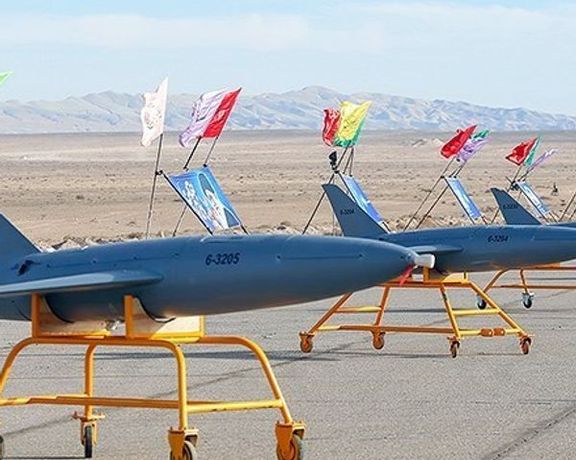
Amid international outcry over the Islamic Republic’s supply of drones and ballistic missiles for the Russian invasion of Ukraine, Kiev says Tehran plans to ship even more arms to Russia.
According to reports by Ukranian intelligence agencies, the Islamic Republic is set to deliver more than 200 Shahed-136 and Arash-2 kamikaze drones, and Mohajer-6 reconnaissance and combat UAVs later in November.
“It is known that the supply of these UAVs will be carried out over the Caspian Sea to the port of Astrakhan,” the Ukrainian intelligence agency said, adding that “The drones will arrive disassembled. Later, on the territory of Russia, they will be assembled, repainted and applied with Russian markings,” the report says. Russia applies its own markings to the Shahed-131 and the Shahed-136, dubbing them the Geran-1 and Geran-2 respectively – apparently to obscure their Iranian origins.
According to a report by CNN, Tehran is preparing to send approximately 1,000 additional weapons, including surface-to-surface short range ballistic missiles and more attack drones to Russia to use in its war against Ukraine.
The Paris-based dissident organization National Council of Resistance of Iran (NCRI) -- affiliated with exiled People’s Mojahedin Organization of Iran (PMOI/MEK) -- accused the Iranian regime of supplying Vladimir Putin’s army with more than 3,500 drones.
Ukraine, however, said that roughly 400 drones have already been used by Russia, from a total supply of approximately 2,000 weapons. President Volodymyr Zelenskyy announced the downing of 223 drones produced by Iran’s regime.
On Tuesday, the US State Department Spokesperson Ned Price said Washington will “continue to vigorously enforce all US sanctions on both the Russian and Iranian arms trade to make it harder for Iran to sell these weapons to Russia.”